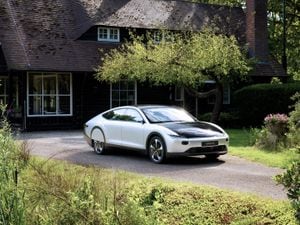5 things you need to know about the Lightyear One – a solar-powered electric car
We explore the sun-powered EV that’s set to arrive before the end of the year.

As we edge ever closer to 2030, when new petrol and diesel cars will no longer be able to be sold, electric models are becoming increasingly popular – and there are plenty of big questions being asked about EVs.
How will I charge them if I can’t plug in at home? Will they overload the grid? Is the electricity as environmentally friendly as we think? All worthy questions that will have to be answered.

But imagine if a car could answer all of those questions in one swipe. Well, the Lightyear One might just do that, as it’s the first long-range solar car. Confirmed today to be commercially available from the end of 2021, it could help to answer the question of EV charging.
Here are five things to know about it…
It has an enormous solar panel on the roof

When it comes to powering our houses using the sun, the roofs of buildings are plastered in solar panels. So you’re probably wondering how the same can be achieved with a car with a much smaller amount of space for panels?
Well, the Lightyear One’s roof and rear ‘window’ is plastered in five square metres of solar panels that manage to harness the energy from the sun to charge the car’s battery, allowing for a claimed range of 450 miles.
Even in The Netherlands, where the One will be produced, it’s said to be able to offer more than 6,000 solar-powered miles in a year. The rest of the time, it can simply be charged like a normal EV, though Lightyear says they expect owners to only have to charge at the mains once per month.
The best aerodynamics of any production car

Perhaps unsurprisingly, there’s a heavy concentration on efficiency here, and it’s no huge surprise that with the Lightyear’s sleek body it has the lowest aerodynamic coefficient of any production car today.
This is achieved through its swoopy elongated shape, along with details such as its wheel spats – covers that go over the wheels to reduce drag.
New tyres specifically developed for it

To enhance efficiency further, the Lightyear One has a set of tyres that have been specifically developed for it.
Announced today as part of an ongoing collaboration with Bridgestone, special tyres have been developed to have as little rolling resistance as possible – achieved through a new tread pattern and a narrow width, but large diameter and high inflation pressures. Called Turanza Eco tyres, they offer a 90kg saving (across four tyres) compared to the typical rubber used on an electric car.
It’s still a practical car you could use every day

You might expect the Lightyear One to be some far-flung concept that can’t be used every day, but that’s far from the case. Thanks to generous proportions – it’s roughly the same length as a seven-seat Audi Q7 SUV – it can seat five, while the boot measures a huge 780 litres of luggage capacity.
It’ll be available from the end of 2021, and it might even come to the UK

A solar-powered car might seem like a far-flung concept that’s set to remain on a motor show stand, but the Lightyear One really is making production, and from as early as this year after a long time in development.
Set to be available across various countries in Europe, Lex Hoefsloot, CEO of Lightyear said that the One could come to the UK, though it is likely to be available in left-hand-drive only.
And the cost? Well, pioneering technology is rarely cheap, and it’s safe to say this car isn’t. With early high-spec models costing €150,000 (£130,000), you really will have to be committed to the cause/





